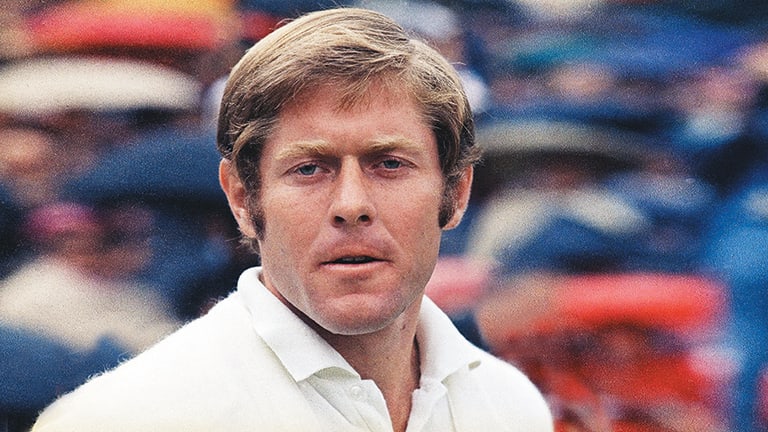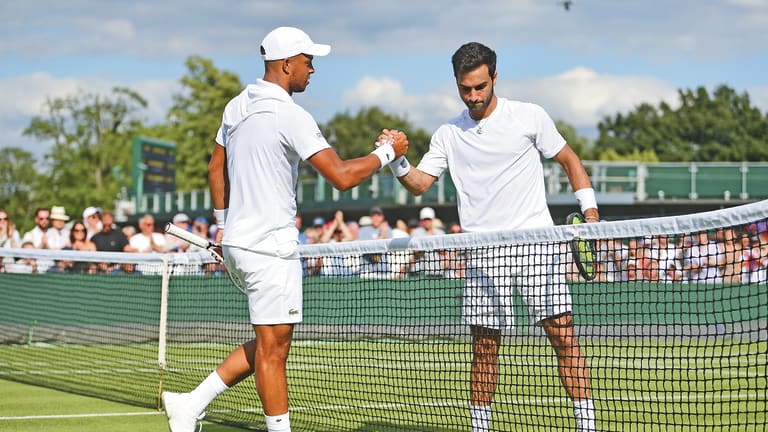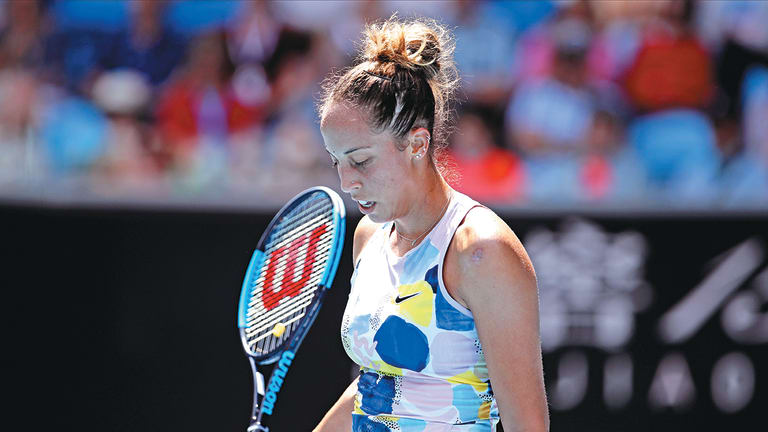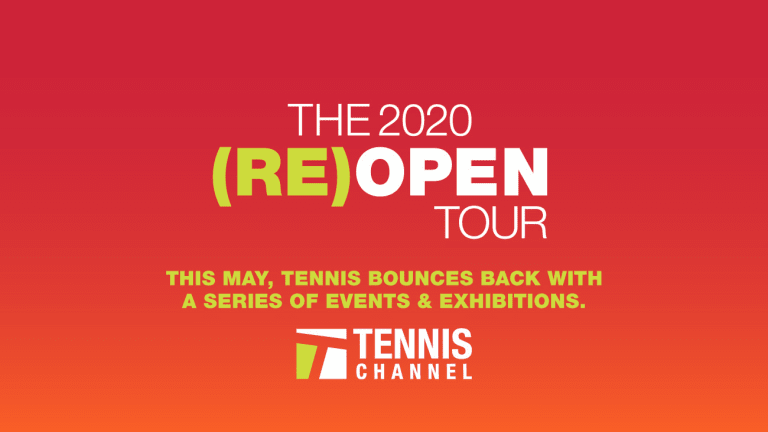Can tennis help destigmatize discussions of mental health in sports?
By Steve Tignor Jun 16, 2020Social
PHOTOS: Aryna Sabalenka, Jessica Pegula step out in style for Wuhan player party
By Baseline Staff Oct 07, 2024Beijing, China
Aryna Sabalenka wins 14th straight at China Open; Naomi Osaka to face Coco Gauff
By Associated Press Sep 30, 2024Week In Preview
Previews: Aryna Sabalenka in China Open; Laver Cup stars, including Carlos Alcaraz, in Tokyo and Beijing
By Steve Tignor Sep 23, 2024US Open
US Open nightcap: Sabalenka, Ruud, Mertens mount comebacks; Nakashima to face Zverev
By TENNIS.com Aug 31, 2024Pop Culture
TIEBREAK, the ATP and WTA's official video game, launches on multiple platforms
By Baseline Staff Aug 22, 2024Style Points
PHOTOS: Coco Gauff, Taylor Fritz & co. unveil Team USA's moto-inspired Olympic fits
By Stephanie Livaudais Jul 24, 2024Social
Home improvement, wedding dress shopping have been on injured Madison Keys' to-do list
By Baseline Staff Jul 22, 2024Olympics
To go or not to go? How the Olympic tennis participation decision affects the sport
By Peter Bodo Jul 22, 2024Social
“Use sunscreen!”: Andy Roddick shares skin cancer diagnosis, and a general PSA for all players
By Liya Davidov Jul 21, 2024Can tennis help destigmatize discussions of mental health in sports?
Tennis prizes self-reliance, and players from Mardy Fish to Noah Rubin and Madison Keys are fighting for more mental health awareness.
Published Jun 16, 2020
Advertising
For more on recreational tennis during this unprecedented time—including the best quarantine workout; a guide to improving your ball toss from your couch; what the pros have done to stay active; nutrition tips, advice on how to cope with COVID-19; and drills while hitting against a wall (of any size)—click here.
In the late 1960s and early 1970s, he had been ranked No. 1 in the United States, and as high as No. 6 in the world. He had led his country to a Davis Cup title. He had reached the quarterfinals or better at all four Grand Slam tournaments, and twice made it to the semifinals at the US Open.
Nicknamed The Bull, this wiry, no-nonsense native son of West Texas was one of tennis’ tough guys. On court, despite being just 5’9”, he was a hard- charging serve-and-volleyer; off court, he drank as hard as an athlete’s lifestyle would allow. In a mid-match confrontation that pitted two hot-heads of different generations against each other, Richey even succeeded in getting a young John McEnroe to shut up.
So why, Richey wondered as the ’70s progressed and his 30th birthday approached, was he more on edge than ever? Why, on so many nights, did he find himself going well past his old limit of four beers? Why had he suddenly developed the yips on his backhand? Why couldn’t he sleep until he’d downed 40 milligrams of Valium? Why, one morning before a match in Atlanta, was he still so high he “couldn’t feel his feet when they hit the carpet”?
“I didn’t know what was wrong,” Richey, now 73, says today from his home in San Angelo, Texas. “My brain was in a storm for five or six years. I was self-medicating with alcohol and basically a functional depressive, but I didn’t have that term.”
Richey thought his malaise was just part of life on tour, where loneliness and jet lag are the norm, your friend one day is your opponent the next, and slumps can crush even the most iron-willed player’s soul. Few people, and even fewer male professional athletes, talked about depression in those days. And that went double in tennis, a sport with a strong ethos of self-reliance. Among Richey’s peers, Arthur Ashe was one of the few who expressed concern about his work-hard, play-hard lifestyle.
“I always had bad anxiety, even in the juniors, but I wrote it off,” Richey says. “I didn’t know it wasn’t normal. In my family, it was nothing but tennis, and I’d always worried about how good I was compared to others.”

Richey's greatest challenge was discovering his true opponent.
© AP
Advertising
Richey was a highly accomplished player, but his toughest battle had nothing to do with forehands and backhands. “Cliff is my friend and his crusade to draw more attention to depression will not be easy,” wrote Jimmy Connors in Richey’s first book, Acing Depression: A Tennis Champion’s Toughest Match. “But he has never been afraid of a fight. With his energy and focus, it is a challenge that can be met.” (Getty Images)
For Richey, tennis was a double-edged sword for his anxiety. On the one hand, the sport heightened it; on the other, his nerves served as a motivator.
“I like things that are clear cut, and I liked that in tennis you either won or lost,” he says. “But there’s also nowhere to hide. Whatever you did, it was in the newspaper the next day. “The one thing I could fall back on was my skill. I could always count on that to get me where I wanted to go.”
Until he couldn’t. By 1979, Richey’s skill was no longer enough to keep him on tour. But even as his tennis game was declining, his golf game was improving, and by the early 1990s, he had joined the Celebrity Player’s golf tour. It didn’t take long for the old demons to follow him from the court to the course.
“Two years into the tour, I was losing my [golf] game, replaying my horror of losing my tennis game,” Richey says.
For a second time, Richey’s safety net—his athletic ability—had been pulled out from under him. This time depression hit harder. Richey plastered black garbage bags on his windows—”my mind became dark.” He says he was largely “non-functional” from 1994 to ’97. Yet it wasn’t until 1996, when he visited his dermatologist, who was also a family friend, that Richey understood what was happening to him, and what he needed to do about it.
“I laid my heart out,” Richey says.
After his dermatologist helped secure him a prescription for an anti-depressant, Richey quit drinking, got therapy, and started taking Zoloft. “I’m happy to be on it,” he says, while reiterating that he isn’t “cured” of depression. He returned to the golf tour and retired from his second sport in 2007.
“I always knew from tennis that you change a losing game, and it was time for me to change,” Richey says. “Once I understood what was happening to me, I made depression my ultimate opponent.”

Rubin (right), who stepped away from pro tennis earlier this year, believes the sport's relentless structure lends itself to mental health burdens.
© AP
Advertising
Rubin won the Wimbledon junior title in 2014, but hasn’t reached the second round there as a pro. His rocky transition to the ATP tour began a downward spiral that, eventually, inspired him to create something that helped not only him, but other struggling pros. (Getty Images)
Earlier this decade, Mardy Fish talked openly about his struggles with an anxiety disorder, and Serena Williams has done the same about her postpartum depression. But the stigma around discussing mental health has stubbornly endured.
“You see it written about more now,” Richey says, “but it hasn’t changed nearly enough.”
Noah Rubin, a 24-year-old player from Long Island, wants to do something about that. Unlike Richey, a baby boomer born in 1946, Rubin, a Millennial born in 1996, is already well-versed in the subjects of anxiety and depression. He has experienced them first-hand, and sought professional help. During his five years on tour, he has also observed the symptoms of them in his fellow players.
“I’m passionate about mental health,” Rubin says. “I’m passionate about knowing my feelings and sharing what I feel.”
In the juniors and college, Rubin met with little but success. When he was a student at John McEnroe’s academy in New York, McEnroe called him “the most talented player we’ve come across.” Rubin won the boys’ title at Wimbledon in 2014, and reached the NCAA Division I final as a freshman.
But as it has been for so many other talented young players, the pro tour was a steeper hill to climb. Despite making improvements to his game, and pushing Roger Federer hard at the 2017 Australian Open, Rubin has never been ranked higher than No. 125. The low point came at a Challenger event in Spain in 2018, when he found himself alone in a dark and near-empty club at 11 at night, having just lost his fifth straight match, “with tears slowly dripping down my face.”
But Rubin also discovered that he wasn’t the only player who felt alone. The life of the rank-and-file pro, and the struggles he or she faces, hadn’t changed much since Richey’s day. The travel was just as arduous, the jet lag just as debilitating, the slumps just as devastating, and the money worries just as vexing.
“You’re by yourself most of the time, and you’re dealing with failure most of the time,” Rubin says. “You’re struggling financially. It has a snowball effect.”
According to Rubin, something else hasn’t changed since Richey’s day: alcohol as a survival tool.
“I know a lot of players who, to cope and to get ready for the next week, spend 12 hours drinking,” Rubin told The Daily Telegraph last year.
To Rubin, tennis’ structure only exacerbates these problems. The season is too long, the best-of-five-set matches too grueling, and the chase for money and ranking points too frenzied.
To help shine a brighter light on his fellow players’ lives, Rubin did what any social-media-savvy Millennial might do: he created an Instagram account. Called Behind the Racquet, it’s a place where pros of all levels can share their stories. In part, Rubin sees the site as a way to advertise the game to a generation of fans who are accustomed to knowing everything—the good, the bad, and the ugly—about their favorite celebrities.
“I feel like there’s a disconnect between tennis players and fans,” Rubin says. “The way the sport is promoted, fans can’t relate to players at a deeper level.”
Traditionally, tennis players have been leery about broadcasting their vulnerabilities to their fellow pros. “I’m not here to make friends” has always been an acceptable, even admirable, philosophy on tour. Rubin calls those concerns “antiquated.”
“If I’m in a third set, I’m not thinking about something my opponent revealed about himself in the past; it doesn’t work that way,” Rubin says. “There’s this toxic masculinity in sports, that you have to be the alpha male, but I don’t think that’s relevant in a match.”
If the response from his fellow players is any indication, Rubin is onto something. Behind the Racquet now features the personal and sometimes painful stories of more than 100 people from across the sport. Women and men, Top 10 players and Challenger players, active pros and retired pros, 40-somethings and teenagers, fans and announcers: Rubin tries to offer a space where everyone can open up.
In April, 16-year-old Coco Gauff caused a stir when she posted that she had been “really depressed” in the year leading up to her 2019 breakthrough. (Coco’s father later clarified her comment, and Rubin believes he made an error in editorial judgement.) If it’s startling to hear a young superstar talk about depression, Rubin hopes his site will make it less so.
“I wanted Behind the Racquet to be a form of therapy,” Rubin says, “to start the conversation and get people to at least think about how they’re feeling. We need to normalize talking about anxiety.”

Can tennis help destigmatize discussions of mental health in sports?
© AP
Advertising
For Behind the Racquet, Roberto Bautista Agut tells the story of how he dealt with the deaths of his parents, and Madison Keys talks about being judged for her weight at 15, by people who saw her on TV. “Eventually, that truly got into my head,” she says. (Getty Images)
That revolution came too late to prolong Richey’s career, but he has seen the benefits since. In 2010, he teamed with his daughter, Hilaire Kallendorf, to write Acing Depression: A Tennis Champion’s Toughest Match, a memoir of his peaks and valleys on tour.
“As you can probably guess, I wasn’t the world’s greatest father when I was a player,” Richey says. “But doing this book really brought my daughter and I closer.”
Along with personal healing, the book gave Richey an identity far removed from that of most former professional athletes. He became a regular speaker at mental-health conferences, and has helped counsel hundreds of fellow sufferers over the years. In 2017, he published a second book, with Mary Garrison, Your Playbook for Beating Depression.
Like the net-rusher he once was, Richey has fought his demons by understanding his opponent, and going to battle with it.
“So many people still don’t know what the signs are for depression,” Richey says. “I tell them, ‘Know what loss is getting to you. Read up on the disease. Address the issue.’
“Tennis is a selfish sport. Everything’s about you. So it means something to me to think that I could help save some people. I’d like to be known as a pretty darn good tennis player, and a mental health advocate.”
“I love kicking depression’s ass any chance I can get.”

Can tennis help destigmatize discussions of mental health in sports?